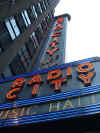 |
New York
Architecture Images- Midtown Radio City Music Hall |
|
architect |
Edward Durell Stone (architect) and Donald Deskey (interior) |
|
location |
Sixth Ave at 50th St. |
|
date |
1932 |
|
style |
Art Deco |
|
construction |
|
|
type |
Theater |
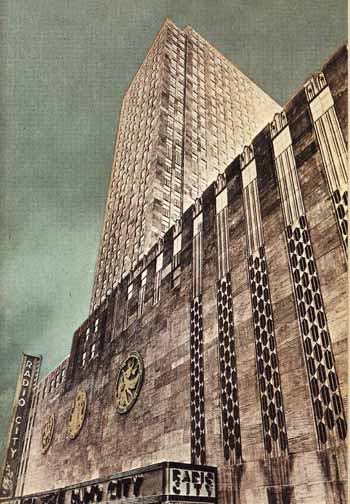 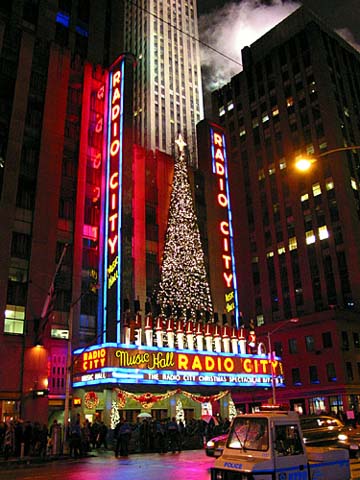 |
|
|
|
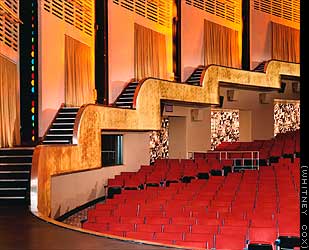  |
|
images |
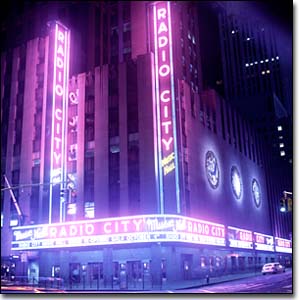 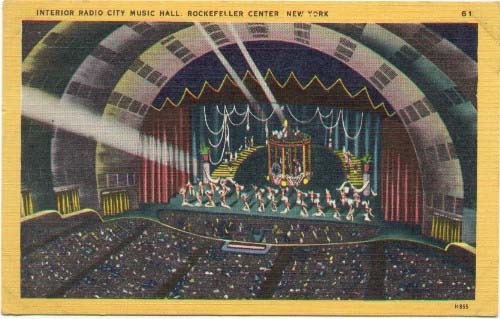 |
 |
|
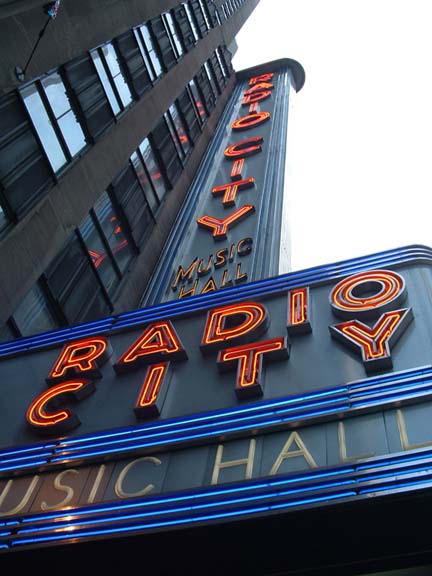 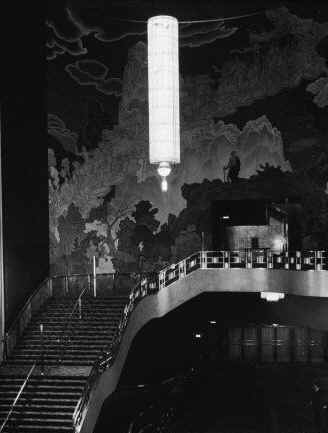 |
|
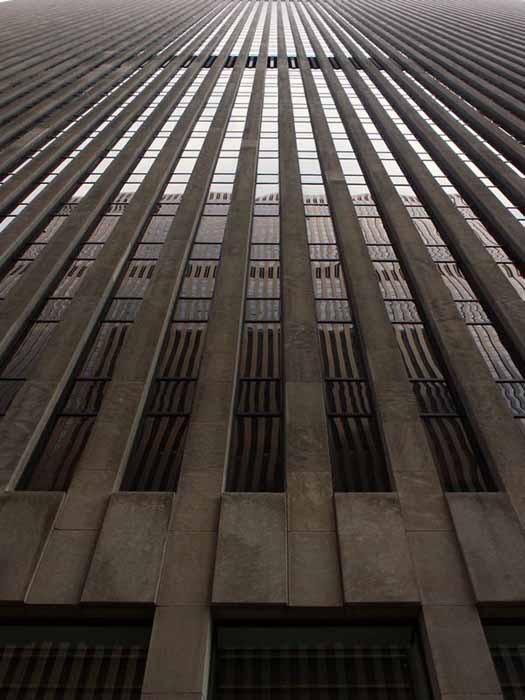 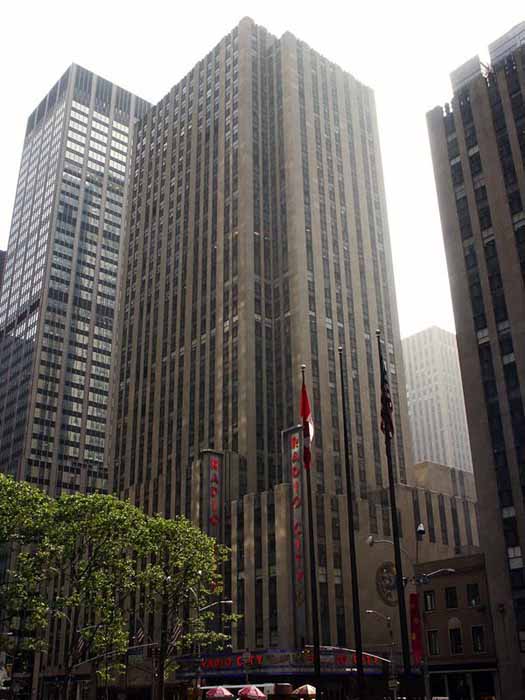 |
|
| Images- with special thanks to Rick Stasel | |
| A vestige of the large entertainment component found in the earlier plan for Rockefeller Center, this theater was a larger version of the music halls and theaters around Times Square. Originally intended for use as a vaudeville music hall which would be "the showplace of the nation," this theater features a stunning Art Deco interior decorated with golden rays and plaster arches. At the time it was built, the theater had many innovative technical features including a revolving stage, three moveable sections of stage flooring, and sophisticated scenery equipment. When the success of this theater was threatened by the newly popular genre of sound film, it was taken over by Rockefeller Center and RCA. After being adapted as a movie theater for a brief period of time, the facility was resurrected as a music hall and immortalized by the famous chorus line dancers known as the Rockettes. | |
![[New York, NY: Center Theatre]](usa_nyc_center.jpg) ![[New York, NY: Center Theatre]](usa_nyc_center_2.jpg)
|
|
|
Radio City Music Hall is an entertainment venue located in New York City's
Rockefeller Center. Its nickname is the Showplace of the Nation, and it
was for a time the leading tourist destination in the city. Its interior
was declared a city landmark in 1978. Early history The 12 acre (49,000 m²) complex in midtown Manhattan known as Rockefeller Center was developed between 1929 and 1940 by John D. Rockefeller, Jr., on land leased from Columbia University. Rockefeller initially planned a new home for the Metropolitan Opera on the site, but after the Stock Market Crash of 1929, the plans changed and the opera company withdrew from the project. The names "Radio City" and "Radio City Music Hall" derive from one of the complex's first tenants, the Radio Corporation of America. Radio City Music Hall was a project of Rockefeller, Samuel Roxy Rothafel who previously opened the Roxy Theater in 1927, and RCA chairman David Sarnoff. RCA had developed numerous studios for NBC at 30 Rockefeller Plaza, just to the south of the Music Hall, and the radio-TV complex that lent the Music Hall its name is still known as the NBC Radio City Studios. The Music Hall opened to the public on December 27, 1932 with a spectacular stage show, featuring Ray Bolger and Martha Graham. The opening was meant to be a return to high class variety entertainment. Unfortunately, it was not a success and on January 11, 1933, the first film was shown on the giant screen: Frank Capra's The Bitter Tea of General Yen starring Barbara Stanwyck. Radio City has 5,933 seats for spectators; it became the largest movie theater in the world at the time of its opening. Designed by Edward Durell Stone, the interior of the theater, by Donald Deskey, incorporates glass, aluminum, chrome, and geometric ornamentation. Deskey rejected the Rococo embellishment generally used for theaters at that time in favor of a contemporary Art Deco style, borrowed heavily from a European Modern aesthetic style, of which he was the foremost exponent at the time. For much of the theater's history, it presented both a movie and a stage show as part of the same program. By the 1970s, changes in film distribution made it difficult for Radio City to secure exclusive bookings of many films; furthermore, the theater preferred to show only G-rated movies, which became less common as the decade wore on. Regular film showings at Radio City ended in 1979, when Radio City was saved from a possible closure due to lack of funds. Movies and Movie premieres have occasionally been shown there in succeeding years. In 1980 after a renovation the Music Hall reopened with a focus on concerts and live stage shows. Attractions Radio City's marquee promoting the Christmas Spectacular in December 2007.The Great Stage, measuring 66.5 feet (20 m) deep and 144 feet (44 m) wide, resembles a setting sun. Its system of elevators was so advanced that the U.S. Navy incorporated identical hydraulics in constructing World War II aircraft carriers; according to Radio City lore, during the war, government agents guarded the basement to assure the Navy's technological advantage. The Music Hall's Mighty Wurlitzer pipe organ is the largest theater pipe organ built for a movie theater: Twin identical consoles flank both sides of the Great Stage, 144 feet apart; its 4,410 pipes are installed in chambers on either side of the proscenium's arch. Installed in 1932, the instrument was the largest produced by the Rudolph Wurlitzer Manufacturing Company of North Tonawanda, New York; it was built as a serious concert instrument rather than to accompany silent movies, capable of playing many styles of music including classical organ literature. A rebuild of the historic organ was undertaken that was completed in time for the theater's restoration in 1999. A smaller Wurlitzer organ was installed in the theater's radio studios, but was put into storage when the studio was converted into office space. The theater is home to the Radio City Christmas Spectacular, a New York Christmas tradition since 1933, and to the women's precision dance team known as The Rockettes. Currently owned and managed by Cablevision, the theater is also used for a variety of concerts and special events: In 1998, Latin pop artist Luis Miguel held shows in the hall by selling out five consecutive shows in five straight nights, and also sold out four straight nights in four straight concerts in 2000. Famous progressive metal band, Dream Theater, recorded their concert here on April 1, 2006 during their 20th anniversary tour and released it on a 3CD/2DVD live album named Score. Heaven and Hell recorded their March 30, 2007 concert here, releasing it as a two CD live album and DVD, Heaven and Hell: Live from Radio City Music Hall. The Music Hall is the usual regular home of the Daytime Emmy Award ceremony (although the 2006 and 2007 shows were held in Los Angeles) and the Tony Awards (with occasional sojourns into local theaters). The hall is the frequent site of the annual MTV Video Music Awards (although the ceremony has occasionally been held since the 1990s in other cities such as Los Angeles, Miami, and in 2007, Las Vegas). It has often been the venue for the Grammy Awards in years when New York has won the bid (usually over Los Angeles) to host the show (although New York's Madison Square Garden, also owned by Cablevision, were hosts in 2003). On January 15, 2000, Radio City Music Hall played host to its first ever sports event, a boxing card that featured undisputed light heavyweight champion Roy Jones, Jr. defeating David Telesco in the main event, and in the co-feature heavyweight David Izon defeating Derrick Jefferson. The New York Liberty played some of their 2004 home games at Radio City while Madison Square Garden was reserved for the Republican National Convention. The Great Stage has been home to the NFL Draft since 2006. (The Draft was previously held at Madison Square Garden until Cablevision's opposition over a proposed Jets stadium caused the NFL to move the 2005 draft to the Jacob Javits Convention Center. After the stadium dispute was settled, the NFL moved the draft to another Cablevision-owned venue, Radio City.) In addition, Radio City Music Hall is also the regular home of commencement ceremonies for Hunter College and Pace University's New York City campus. Further reading Okrent, Daniel. Great Fortune: The Epic of Rockefeller Center, New York: Viking Press, 2003. Roussel, Christine. The Art of Rockefeller Center, New York: W.W. Norton & Company, 2006. |
|
|
Built 1932 as "RKO Roxy Theatre" by Reinhart &
Hoffmeister; Corbett, Harrison & MacMurray; Hood & Foulihoux. Opened 29
Dec 1932. 3509 seats. Originally used for film-and-stage shows. 1934
renamed "Center Theatre". Subsequently used for musical performances.
1940 installation of an ice rink stage facility. Subsequently, used for
shows on ice. From 1950, used as a TV studio. Demolished in 1955 in
favour of an office block.
Special thanks to CARTHALIA Andreas Praefcke's postcard collection of theatres. |
|